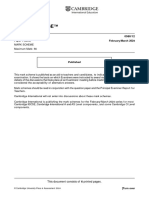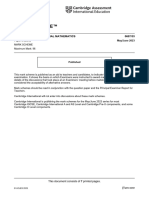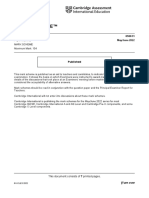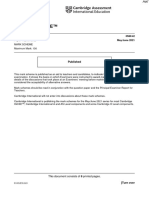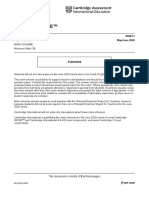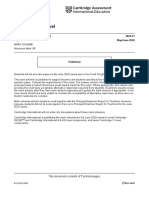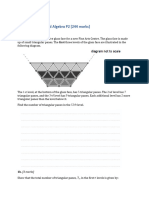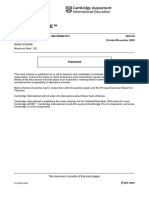Cambridge IGCSE™: Cambridge International Mathematics 0607/61 October/November 2020
Cambridge IGCSE™: Cambridge International Mathematics 0607/61 October/November 2020
Uploaded by
nathan.kimCopyright:
Available Formats
Cambridge IGCSE™: Cambridge International Mathematics 0607/61 October/November 2020
Cambridge IGCSE™: Cambridge International Mathematics 0607/61 October/November 2020
Uploaded by
nathan.kimOriginal Title
Copyright
Available Formats
Share this document
Did you find this document useful?
Is this content inappropriate?
Copyright:
Available Formats
Cambridge IGCSE™: Cambridge International Mathematics 0607/61 October/November 2020
Cambridge IGCSE™: Cambridge International Mathematics 0607/61 October/November 2020
Uploaded by
nathan.kimCopyright:
Available Formats
Cambridge IGCSE™
CAMBRIDGE INTERNATIONAL MATHEMATICS 0607/61
Paper 6 (Extended) October/November 2020
MARK SCHEME
Maximum Mark: 60
Published
This mark scheme is published as an aid to teachers and candidates, to indicate the requirements of the
examination. It shows the basis on which Examiners were instructed to award marks. It does not indicate the
details of the discussions that took place at an Examiners’ meeting before marking began, which would have
considered the acceptability of alternative answers.
Mark schemes should be read in conjunction with the question paper and the Principal Examiner Report for
Teachers.
Cambridge International will not enter into discussions about these mark schemes.
Cambridge International is publishing the mark schemes for the October/November 2020 series for most
Cambridge IGCSE™, Cambridge International A and AS Level and Cambridge Pre-U components, and some
Cambridge O Level components.
This document consists of 7 printed pages.
© UCLES 2020 [Turn over
0607/61 Cambridge IGCSE – Mark Scheme October/November 2020
PUBLISHED
Generic Marking Principles
These general marking principles must be applied by all examiners when marking candidate answers. They
should be applied alongside the specific content of the mark scheme or generic level descriptors for a question.
Each question paper and mark scheme will also comply with these marking principles.
GENERIC MARKING PRINCIPLE 1:
Marks must be awarded in line with:
• the specific content of the mark scheme or the generic level descriptors for the question
• the specific skills defined in the mark scheme or in the generic level descriptors for the question
• the standard of response required by a candidate as exemplified by the standardisation scripts.
GENERIC MARKING PRINCIPLE 2:
Marks awarded are always whole marks (not half marks, or other fractions).
GENERIC MARKING PRINCIPLE 3:
Marks must be awarded positively:
• marks are awarded for correct/valid answers, as defined in the mark scheme. However, credit is given
for valid answers which go beyond the scope of the syllabus and mark scheme, referring to your Team
Leader as appropriate
• marks are awarded when candidates clearly demonstrate what they know and can do
• marks are not deducted for errors
• marks are not deducted for omissions
• answers should only be judged on the quality of spelling, punctuation and grammar when these features
are specifically assessed by the question as indicated by the mark scheme. The meaning, however,
should be unambiguous.
GENERIC MARKING PRINCIPLE 4:
Rules must be applied consistently, e.g. in situations where candidates have not followed instructions or in
the application of generic level descriptors.
GENERIC MARKING PRINCIPLE 5:
Marks should be awarded using the full range of marks defined in the mark scheme for the question
(however; the use of the full mark range may be limited according to the quality of the candidate responses
seen).
GENERIC MARKING PRINCIPLE 6:
Marks awarded are based solely on the requirements as defined in the mark scheme. Marks should not be
awarded with grade thresholds or grade descriptors in mind.
© UCLES 2020 Page 2 of 7
0607/61 Cambridge IGCSE – Mark Scheme October/November 2020
PUBLISHED
Maths-Specific Marking Principles
1 Unless a particular method has been specified in the question, full marks may be awarded for any
correct method. However, if a calculation is required then no marks will be awarded for a scale
drawing.
2 Unless specified in the question, answers may be given as fractions, decimals or in standard form.
Ignore superfluous zeros, provided that the degree of accuracy is not affected.
3 Allow alternative conventions for notation if used consistently throughout the paper, e.g. commas
being used as decimal points.
4 Unless otherwise indicated, marks once gained cannot subsequently be lost, e.g. wrong working
following a correct form of answer is ignored (isw).
5 Where a candidate has misread a number in the question and used that value consistently
throughout, provided that number does not alter the difficulty or the method required, award all
marks earned and deduct just 1 mark for the misread.
6 Recovery within working is allowed, e.g. a notation error in the working where the following line of
working makes the candidate’s intent clear.
MARK SCHEME NOTES
The following notes are intended to aid interpretation of mark schemes in general, but individual mark schemes
may include marks awarded for specific reasons outside the scope of these notes.
Types of mark
M Method marks, awarded for a valid method applied to the problem.
A Accuracy mark, awarded for a correct answer or intermediate step correctly obtained. For accuracy
marks to be given, the associated Method mark must be earned or implied.
B Mark for a correct result or statement independent of Method marks.
When a part of a question has two or more ‘method’ steps, the M marks are in principle independent unless the
scheme specifically says otherwise; and similarly where there are several B marks allocated. The notation ‘dep’
is used to indicate that a particular M or B mark is dependent on an earlier mark in the scheme.
Abbreviations
awrt answers which round to
cao correct answer only
dep dependent
FT follow through after error
isw ignore subsequent working
nfww not from wrong working
oe or equivalent
rot rounded or truncated
SC Special Case
soi seen or implied
© UCLES 2020 Page 3 of 7
0607/61 Cambridge IGCSE – Mark Scheme October/November 2020
PUBLISHED
Question Answer Marks Partial Marks
A INVESTIGATION PILING SQUARES
1(a) 1
1(b)(i) 2 B1 for 3 correct
s 1 2 3 4 5 6 7
T 1 3 6 10 15 21 28
1(b)(ii) Substitution of two pairs of values from C1 FT their 1(b)(i)
their table
or at least 3 second differences of 1
or use of general quadratic with
differences
or triangle numbers stated
1 B2 B1 for each
x= oe
2
1
y= oe
2
1(b)(iii) their x × 82 + their y × 8 oe 1 FT their 1(b)(ii)
28 + 8 B1
or difference of 8 seen below table
or 1 + 2 + … + 8
8×9
or
2
or diagram labelled up to 36
36 seen twice nfww B1
2(a) 1
2(b) 3 B2 for 4 or 5 cells correct
s 1 2 3 4 5 6 7 or B1 for 2 or 3 cells correct
b 0 1 2 4 6 9 12
w 1 2 4 6 9 12 16
T 1 3 6 10 15 21 28
© UCLES 2020 Page 4 of 7
0607/61 Cambridge IGCSE – Mark Scheme October/November 2020
PUBLISHED
Question Answer Marks Partial Marks
2(c)(i) 1 B1 for 25
Odd s 1 3 5 7 9
b 0 2 6 12 20
Even s 2 4 6 8 10
b 1 4 9 16 25
2(c)(ii) Substitution of two pairs of values from C1 FT their ‘odd’ table in 2(c)(i)
their table
1 2 B1 for each
x= oe
4
1
y = − oe
4
2(c)(iii) b= C1
s
2 B1
oe
2
2(d)(i) 1 B1 for 30
Odd s 1 3 5 7 9
w 1 4 9 16 25
Even s 2 4 6 8 10
w 2 6 12 20 30
2(d)(ii) Substitution of two pairs of values from C1 FT their ‘odd’ table in 2(d)(i)
their table
or trialling (checking) a formula by
substitution of two pairs of values from
their table FT their 1(b)(ii) − their 2(c)(ii)
or correct equivalent expression
or total – black
1 1 1 1
= s2 + s − s2 −
2 2 4 4
1 B2 B1 for each
x=
4
1
y=
2
© UCLES 2020 Page 5 of 7
0607/61 Cambridge IGCSE – Mark Scheme October/November 2020
PUBLISHED
Question Answer Marks Partial Marks
2(d)(iii) 1 2 1 3 M1 for at least three second
w= s + s oe isw differences of 2 seen
4 2
or use of general quadratic with
differences
M1 for n2 + n oe
or for comparison with ‘odd’ table in
2(c)(i)
2(e) Total formula = 253 soi oe C1 FT their x and their y in 1(b)(i)
or continuation of sequence
[Bottom row] = 22 3 B1 for each
[White] = 132
[Black] = 121 If B0 scored SC1 for 23
B MODELLING A BOUNCING BALL
3(a) 1.25 seen oe C1
2.5 10 5
or or or seen
4 16 8
0.625 [m] or 62.5 [cm] B1
3(b)(i) 7.8[1…] or 0.078[1…] or 78.[1…] B1
or 7.8 to 7.813 oe
Correct units to match answer C1
3(b)(ii) 7 1
3(c) Substitution of h and n in h = pqn C1
10 B2 B1 for each
1
oe
2
4 Correct substitution i.e. 0.056 = 35 × q 4 C1
1 B2 0.056
oe nfww M1 for q 4 =
5 35
35
or x4 =
0.056
0.056
or x 4 =
35
5(a)(i) p and explanation that the ball does not 1
bounce
5(a)(ii) The ball bounces up to the same height 1
or the ball never stops bouncing oe
© UCLES 2020 Page 6 of 7
0607/61 Cambridge IGCSE – Mark Scheme October/November 2020
PUBLISHED
Question Answer Marks Partial Marks
5(b) 1 C1 FT their value of q in 3(c)
1 + their 2
10 oe
1
1 − their
2
30 B1 FT their 0 < q < 1 from 3(c)
m C1
5(c) Correct substitution of 40 and 200 C1
2 B2 M1 for clearing fraction
oe
3
6(a)(i) 1 − 0.5 10 C1
leading to
1 – 0.5 7
6(a)(ii) C1
10 1 + 0.5 − 2 0.510
7 1 − 0.5
8.02… B1
6(b) 10 1 + 0.5 C1
7 1 − 0.5
8.32… or 8.33 B1
6(c) Scale on T axis C1
Correct sketch B3 B1 for general shape curving upwards
B1 for intercept within 6 mm of 0
B1 for extension of curve beyond
q = 0.8 dependent on first B1
6(d)(i) 15 1
or 2.14 to 2.143
7
6(d)(ii) 15 1 + q 1 FT their 6(d)(i)
T=
7 1 − q
© UCLES 2020 Page 7 of 7
You might also like
- Edtpa Math Lesson Plans 3Document18 pagesEdtpa Math Lesson Plans 3api-270873656100% (3)
- Data Interpretation Guide For All Competitive and Admission ExamsFrom EverandData Interpretation Guide For All Competitive and Admission ExamsRating: 2.5 out of 5 stars2.5/5 (6)
- Regents Exams and Answers Geometry Revised EditionFrom EverandRegents Exams and Answers Geometry Revised EditionNo ratings yet
- Geoff Petty Formative AssessmentDocument36 pagesGeoff Petty Formative AssessmentLisa Jones100% (1)
- The Six Types of Socratic QuestionsDocument3 pagesThe Six Types of Socratic QuestionsZack100% (3)
- Cambridge IGCSE™: Mathematics 0580/33 May/June 2022Document7 pagesCambridge IGCSE™: Mathematics 0580/33 May/June 2022wallacec1017No ratings yet
- Cambridge IGCSE™: Cambridge International Mathematics 0607/62 February/March 2022Document7 pagesCambridge IGCSE™: Cambridge International Mathematics 0607/62 February/March 2022NandhivarmanNo ratings yet
- Cambridge IGCSE ™: Mathematics 0580/12Document6 pagesCambridge IGCSE ™: Mathematics 0580/12enzeyeeNo ratings yet
- maths 2022 past paper mjDocument7 pagesmaths 2022 past paper mjSIAM PLAZ YTNo ratings yet
- Cambridge IGCSE™: Mathematics 0580/31 May/June 2020Document7 pagesCambridge IGCSE™: Mathematics 0580/31 May/June 2020sibonisoNo ratings yet
- 0607 PaperDocument10 pages0607 PaperPoojaNo ratings yet
- Cambridge IGCSE™Document5 pagesCambridge IGCSE™grengtaNo ratings yet
- Cambridge IGCSE™: Mathematics 0580/31 May/June 2020Document7 pagesCambridge IGCSE™: Mathematics 0580/31 May/June 2020Rehab NagaNo ratings yet
- Cambridge IGCSE™: Cambridge International Mathematics 0607/22 October/November 2020Document5 pagesCambridge IGCSE™: Cambridge International Mathematics 0607/22 October/November 2020Lorraine Sabbagh100% (1)
- Cambridge IGCSE™: Mathematics 0580/12 March 2020Document6 pagesCambridge IGCSE™: Mathematics 0580/12 March 2020Shayan NaveedNo ratings yet
- This Is BookDocument9 pagesThis Is BookAdarsh DubeNo ratings yet
- Cambridge IGCSE™Document7 pagesCambridge IGCSE™grengtaNo ratings yet
- Cambridge IGCSE Maths 0580 31 Paper 3 Core Mark Scheme Nov 2020Document7 pagesCambridge IGCSE Maths 0580 31 Paper 3 Core Mark Scheme Nov 2020reemabousteitNo ratings yet
- Cambridge IGCSE™: Mathematics 0580/31 May/June 2022Document7 pagesCambridge IGCSE™: Mathematics 0580/31 May/June 2022ivan micoNo ratings yet
- Cambridge IGCSE™: Cambridge International Mathematics 0607/63 May/June 2020Document6 pagesCambridge IGCSE™: Cambridge International Mathematics 0607/63 May/June 2020Karthikeya ShukklaNo ratings yet
- Cambridge IGCSE™: Mathematics 0580/42 March 2021Document10 pagesCambridge IGCSE™: Mathematics 0580/42 March 2021Nyan Lin HsetNo ratings yet
- Cambridge IGCSE ™ (9-1) : Mathematics 0980/31 October/November 2022Document8 pagesCambridge IGCSE ™ (9-1) : Mathematics 0980/31 October/November 2022scepticsNo ratings yet
- Cambridge O Level: Mathematics (Syllabus D) 4024/12 October/November 2021Document7 pagesCambridge O Level: Mathematics (Syllabus D) 4024/12 October/November 2021Alameen JamanNo ratings yet
- June 2020 (v3) MS - Paper 3 CIE Maths IGCSEDocument7 pagesJune 2020 (v3) MS - Paper 3 CIE Maths IGCSEDIY TaskerNo ratings yet
- Cambridge IGCSE™: Cambridge International Mathematics 0607/11 October/November 2020Document5 pagesCambridge IGCSE™: Cambridge International Mathematics 0607/11 October/November 2020nathan.kimNo ratings yet
- Cambridge IGCSE™: Cambridge International Mathematics 0607/42 May/June 2020Document8 pagesCambridge IGCSE™: Cambridge International Mathematics 0607/42 May/June 2020Custard ಥಥNo ratings yet
- Cambridge IGCSE ™: Mathematics 0580/12 October/November 2022Document6 pagesCambridge IGCSE ™: Mathematics 0580/12 October/November 2022Tamuka MarongaNo ratings yet
- March 2021 (v2) MS - Paper 4 CIE Maths IGCSEDocument10 pagesMarch 2021 (v2) MS - Paper 4 CIE Maths IGCSEKinisha KohliNo ratings yet
- Cambridge IGCSE™: Cambridge International Mathematics 0607/32 February/March 2022Document6 pagesCambridge IGCSE™: Cambridge International Mathematics 0607/32 February/March 2022sri manjaNo ratings yet
- Cambridge Assessment International Education: Mathematics 0626/01 May/June 2018Document6 pagesCambridge Assessment International Education: Mathematics 0626/01 May/June 2018AFRAH ANEESNo ratings yet
- Cambridge O Level: Mathematics (Syllabus D) 4024/11 May/June 2022Document7 pagesCambridge O Level: Mathematics (Syllabus D) 4024/11 May/June 2022Ahmad Ali AsifNo ratings yet
- Cambridge O Level: Mathematics (Syllabus D) 4024/12 May/June 2020Document7 pagesCambridge O Level: Mathematics (Syllabus D) 4024/12 May/June 2020Avinash DilipNo ratings yet
- June 2021 (v2) MS - Paper 4 CIE Maths IGCSEDocument8 pagesJune 2021 (v2) MS - Paper 4 CIE Maths IGCSEmoitshepindlovu301No ratings yet
- March 2022 (v2) Ms - Paper 2 Caie Maths IgcseDocument8 pagesMarch 2022 (v2) Ms - Paper 2 Caie Maths IgcseShweta VyasNo ratings yet
- 4024 s22 Ms 12 PDFDocument7 pages4024 s22 Ms 12 PDFMurtaza MustafaNo ratings yet
- Cambridge IGCSE™: Mathematics 0580/22 February/March 2022Document8 pagesCambridge IGCSE™: Mathematics 0580/22 February/March 2022TrynosNo ratings yet
- Feb:March 22-2msDocument8 pagesFeb:March 22-2mscsg5r7q9t5No ratings yet
- Maths 2020 May MS 21Document5 pagesMaths 2020 May MS 21Ahmed MansourNo ratings yet
- June 2020 (v3) MS - Paper 4 CIE Maths IGCSEDocument8 pagesJune 2020 (v3) MS - Paper 4 CIE Maths IGCSEDIY TaskerNo ratings yet
- 4024 s20 Ms 11 PDFDocument7 pages4024 s20 Ms 11 PDFAvinash DilipNo ratings yet
- Cambridge O Level: Mathematics (Syllabus D) 4024/11 May/June 2020Document7 pagesCambridge O Level: Mathematics (Syllabus D) 4024/11 May/June 2020tahir hayatNo ratings yet
- Cambridge IGCSE™: Mathematics 0580/43 May/June 2022Document11 pagesCambridge IGCSE™: Mathematics 0580/43 May/June 2022hildebrandokNo ratings yet
- Cambridge IGCSE™: Mathematics 0580/42 May/June 2021Document8 pagesCambridge IGCSE™: Mathematics 0580/42 May/June 2021Thiru VeleyudhamNo ratings yet
- Cambridge IGCSE™: Mathematics 0580/42 May/June 2022Document9 pagesCambridge IGCSE™: Mathematics 0580/42 May/June 2022Muhammad Anas QasimNo ratings yet
- Cambridge IGCSE™: Cambridge International Mathematics 0607/62 March 2021Document9 pagesCambridge IGCSE™: Cambridge International Mathematics 0607/62 March 2021Custard ಥಥNo ratings yet
- Cambridge IGCSE™: Mathematics 0580/31 October/November 2021Document8 pagesCambridge IGCSE™: Mathematics 0580/31 October/November 2021amos.ndhlovuNo ratings yet
- Cambridge IGCSE™: Cambridge International Mathematics 0607/63 May/June 2022Document8 pagesCambridge IGCSE™: Cambridge International Mathematics 0607/63 May/June 2022hani98970No ratings yet
- Cambridge Assessment International Education: Mathematics 0626/03 May/June 2018Document7 pagesCambridge Assessment International Education: Mathematics 0626/03 May/June 2018AFRAH ANEESNo ratings yet
- Cambridge IGCSE™: Mathematics 0580/13 May/June 2020Document6 pagesCambridge IGCSE™: Mathematics 0580/13 May/June 2020kdebipershadNo ratings yet
- Cambridge IGCSE ™: Mathematics 0580/13Document6 pagesCambridge IGCSE ™: Mathematics 0580/13kushyt041275No ratings yet
- Cambridge Assessment International EducationDocument6 pagesCambridge Assessment International EducationnyiNo ratings yet
- Cambridge Assessment International Education: Mathematics 0580/42 March 2019Document8 pagesCambridge Assessment International Education: Mathematics 0580/42 March 2019Ainalnaem GhidariNo ratings yet
- Cambridge IGCSE™Document8 pagesCambridge IGCSE™grengtaNo ratings yet
- Cambridge O Level: Mathematics (Syllabus D) 4024/11 May/June 2021Document7 pagesCambridge O Level: Mathematics (Syllabus D) 4024/11 May/June 2021Kumail AliNo ratings yet
- Cambridge IGCSE™: Mathematics 0580/32 March 2021Document8 pagesCambridge IGCSE™: Mathematics 0580/32 March 2021sandhya srinivasanNo ratings yet
- Cambridge IGCSE™: Mathematics 0580/43 May/June 2020Document8 pagesCambridge IGCSE™: Mathematics 0580/43 May/June 2020KarimNo ratings yet
- Cambridge IGCSE™ (9-1) : Mathematics 0980/32 May/June 2020Document7 pagesCambridge IGCSE™ (9-1) : Mathematics 0980/32 May/June 2020Siddh SatraNo ratings yet
- Cambridge IGCSE™Document9 pagesCambridge IGCSE™xyz298559No ratings yet
- Cambridge IGCSE™: Mathematics 0580/21 May/June 2020Document7 pagesCambridge IGCSE™: Mathematics 0580/21 May/June 2020HarizZaimNo ratings yet
- Cambridge IGCSE™Document6 pagesCambridge IGCSE™grengtaNo ratings yet
- Cambridge IGCSE ™: Mathematics 0580/42Document10 pagesCambridge IGCSE ™: Mathematics 0580/42Shlok And gauransh legendNo ratings yet
- AP Statistics Flashcards, Fifth Edition: Up-to-Date PracticeFrom EverandAP Statistics Flashcards, Fifth Edition: Up-to-Date PracticeNo ratings yet
- Studies - Number and Algebra P2 MSDocument89 pagesStudies - Number and Algebra P2 MSnathan.kimNo ratings yet
- MYPMaths45Ex 08uu En01Document3 pagesMYPMaths45Ex 08uu En01nathan.kimNo ratings yet
- Studies - Number and Algebra P2Document53 pagesStudies - Number and Algebra P2nathan.kimNo ratings yet
- MYPMaths45Ex 01uu En01Document4 pagesMYPMaths45Ex 01uu En01nathan.kimNo ratings yet
- Studies 2016 May P1Document22 pagesStudies 2016 May P1nathan.kimNo ratings yet
- Studies 2014 May P1Document11 pagesStudies 2014 May P1nathan.kimNo ratings yet
- Cambridge IGCSEDocument8 pagesCambridge IGCSEnathan.kimNo ratings yet
- MAA HL Formula Booklet ExamDocument13 pagesMAA HL Formula Booklet Examnathan.kimNo ratings yet
- Cambridge IGCSE™: Cambridge International Mathematics 0607/42 October/November 2020Document9 pagesCambridge IGCSE™: Cambridge International Mathematics 0607/42 October/November 2020nathan.kimNo ratings yet
- Lesson 30Document1 pageLesson 30Adrayyanna ZilaNo ratings yet
- Step Up L1 Test Yourself Paper 1Document2 pagesStep Up L1 Test Yourself Paper 1Livia UntaruNo ratings yet
- Testing Spoken LanguageDocument6 pagesTesting Spoken LanguageHazel Nebab-FariñasNo ratings yet
- (Language and Literature) : EnglishDocument16 pages(Language and Literature) : EnglishAnonymous WiAkgsIpAwNo ratings yet
- Rubric Ee TheaterDocument5 pagesRubric Ee Theaterapi-307142321No ratings yet
- Arab World English Journal Vplume 8 NumbDocument423 pagesArab World English Journal Vplume 8 NumbAseel Yousef100% (1)
- TOEFL SummaryDocument4 pagesTOEFL SummaryHussain Elsaid ElkotobyNo ratings yet
- Bridget Healy Deposition Jan 13 2006Document78 pagesBridget Healy Deposition Jan 13 2006Claremont Buzz100% (2)
- English Letter ProjectDocument3 pagesEnglish Letter ProjectNikhil SinhaNo ratings yet
- Contract Report 2019 B PDFDocument11 pagesContract Report 2019 B PDFholoNo ratings yet
- EIKEN Advice For ALTs and StudentsDocument12 pagesEIKEN Advice For ALTs and StudentsKevin Weir100% (3)
- Instant download (eBook PDF) Academic Inquiry: Academic Inquiry 4, Essays and Research pdf all chapterDocument41 pagesInstant download (eBook PDF) Academic Inquiry: Academic Inquiry 4, Essays and Research pdf all chapterlososfalkai100% (2)
- Professional Education Drill 12 - Part 6Document1 pageProfessional Education Drill 12 - Part 6saglebal100% (1)
- 2010 May P2 QPDocument32 pages2010 May P2 QPMuhammad UsmanNo ratings yet
- Linking Words For IELTS Speaking - Word List & TipsDocument20 pagesLinking Words For IELTS Speaking - Word List & TipsSameer PatelNo ratings yet
- ENGLISH CTMA - LEVEL 1 - Module1 - Week 3Document12 pagesENGLISH CTMA - LEVEL 1 - Module1 - Week 3DAIBER DANIEL MENDOZA FERIANo ratings yet
- Mamllantino Reported SpeechDocument5 pagesMamllantino Reported SpeechMaría Angeles Martín Llantino0% (1)
- Banking Academy of Vietnam The Faculty of Foreign LanguagesDocument19 pagesBanking Academy of Vietnam The Faculty of Foreign LanguagesVũ Thị Lan HươngNo ratings yet
- Listening and ReadingDocument18 pagesListening and ReadingAyush PandeyNo ratings yet
- Fourth Periodical Test in EnglishDocument4 pagesFourth Periodical Test in EnglishPrecious FlorendoNo ratings yet
- Doing PragmaticsDocument353 pagesDoing PragmaticsYuliia100% (2)
- English Lesson PlanDocument292 pagesEnglish Lesson PlanJenny Mendoza ViañaNo ratings yet
- Saint Angelo Learning Center: Teacher'S Learning Plan English 10Document3 pagesSaint Angelo Learning Center: Teacher'S Learning Plan English 10Princess May Ano-osNo ratings yet
- Objective Test GuideDocument57 pagesObjective Test GuideBobby Elliott100% (22)
- Cambridge IGCSE™: First Language English 0500/11 October/November 2020Document21 pagesCambridge IGCSE™: First Language English 0500/11 October/November 2020daniNo ratings yet
- ESDM AssessmentDocument16 pagesESDM AssessmentNora MouhibNo ratings yet
- Literacy HandbookDocument16 pagesLiteracy Handbookapi-299191866No ratings yet







